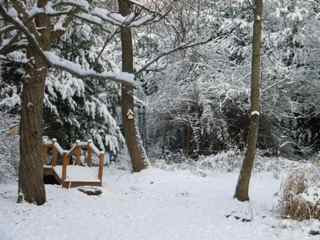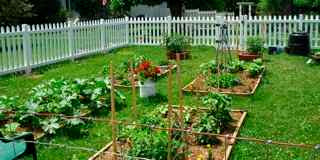 |
| My January Garden |
Happy 2011! I am not very good at keeping new year's resolutions, but I enjoy making them, as I love new beginnings. So when I received an email from our local newspaper,
The Pocono Record, asking for my new year's gardening resolutions, I was ready with an answer. I told Marta, the editor of the 'Home and Garden' section, that I have two main ones: to try square foot gardening and to garden wiser by simplifying.
I have been reading Mel Bartholomew's
All New Square Foot Gardening.
Growing more in less space appeals to me and I am anxious to put some of his ideas into practice in my vegetable garden. I feel my 8' x 4' raised beds lend themselves to this type of gardening.
 |
| My kitchen garden |
As the seed catalogs arrive, I am seeing my vegetable-garden plans in a whole new and exciting light. I would love to hear from other garden bloggers who use or have tried the square foot gardening method.
 |
| 2010 Harvest |
Simplifying is going to be more of a challenge. Sometimes I feel I have 'created a monster' out there with too many gardens to take care of now I am in my 70th year. I read two books that influenced me in my decision to garden wiser: Sydney Eddisons,
Gardening for a Lifetime and Joan Dye Gussow's
Growing, Older.
Both authors are AMAZING, with brilliant insights into the practice of gardening and their philosophy of gardening. I recommend these books to all of you, whatever your age. Actually, it was in a blog that I first heard about these books, but I can't remember whose blog it was. I am sorry I have not given you credit, and if you read this, please let me know who you are.
It is true that the physical labor involved in caring for my garden is becoming increasingly difficult: spreading mulch, digging holes, weeding, lifting containers. So how am I going to simplify? Here is my list:
- Replace high maintenance plants with low maintenance ones.
- Give minimum care - that means being realistic about what I can do.
- Accept imperfections.
- Use labor-saving techniques.
- Accept help.
- Keep any new gardens small and simple (Okay, I know I probably shouldn't be making new gardens, but ... )
I will begin by taking stock ... examining each flower bed as I walk around the gardens. Right now they are blanketed with snow, so I am looking at the (simple) plan I drew of each one. Where I find plants that take up too much time, I will remove and replace them with lower - maintenance plants. I know I have younger gardening friends who will be glad of the gift of some of my more aggressive blooms. For example, every spring I need to dig up large amounts of goosenecked loosestrife and obedient plant. Otherwise, these thugs would soon take over the whole garden.
 |
| Gooseneck Loosestrife: Beautiful but a thug in my garden |
 |
| The not-very-obedient Obedient Plant |
I have already removed the high maintenance New England asters that succumbed to various diseases every year since they were planted.
You can read about this task
here. I am replacing them with shrubs. Other low maintenance plants I intend to use more of are sedums, rudbeckias and daylilies. Also, spring bulbs are so very reliable!
 |
| Rudbeckias tend to be low maintenance |
 |
| The striking red daylily, Chicago Apache, is my favorite |
 |
| This fall I planted many more daffodils - can't wait for spring! |
Shade gardening is definitely less work than any other. I really appreciate my woodland garden and the shade garden close to my house.
 |
| My woodland walk in springtime |
 |
| The shade garden |
Shade garden plants are very low maintenance, especially native ones. My favorite shade garden flower is the hellebore. I plan to plant more of them this year.
 |
| Hellebore |
I am learning more-and-more labor-saving techniques and I hope to write a post about them in the future. For example, using containers is a great labor-saving method. Almost anything will grow in a container.
 |
| Coleus at the entrance to the stone garden |
Eddison recommends we get help as we get older. This can be expensive, so I am fortunate in having HH who does more and more each year to make my task easier, even though he doesn't know a weed from a prize bloom. (I think I was very wise to marry a man younger than me!) In my efforts to simplify, I must learn to accept imperfections in my garden. I need to be realistic in giving the garden a minimum level of care. I have to assure myself that when visitors come into my cottage garden, they wont notice a few weeds. This is a difficult one for me.
Now I am wondering what YOUR new year's resolutions are? If you have not made any yet, you can read Marta's article,
Monroe County Master Gardeners Make Their Resolutions, in the
Pocono Record for some great ideas from the master gardeners in my district.
Again, I wish you health, happiness and great gardening in 2011!
Love,
Pamela x
~~ I love reading your comments. I hope you leave one so I’ll know you visited!
I look forward to visiting your blog in return.




































